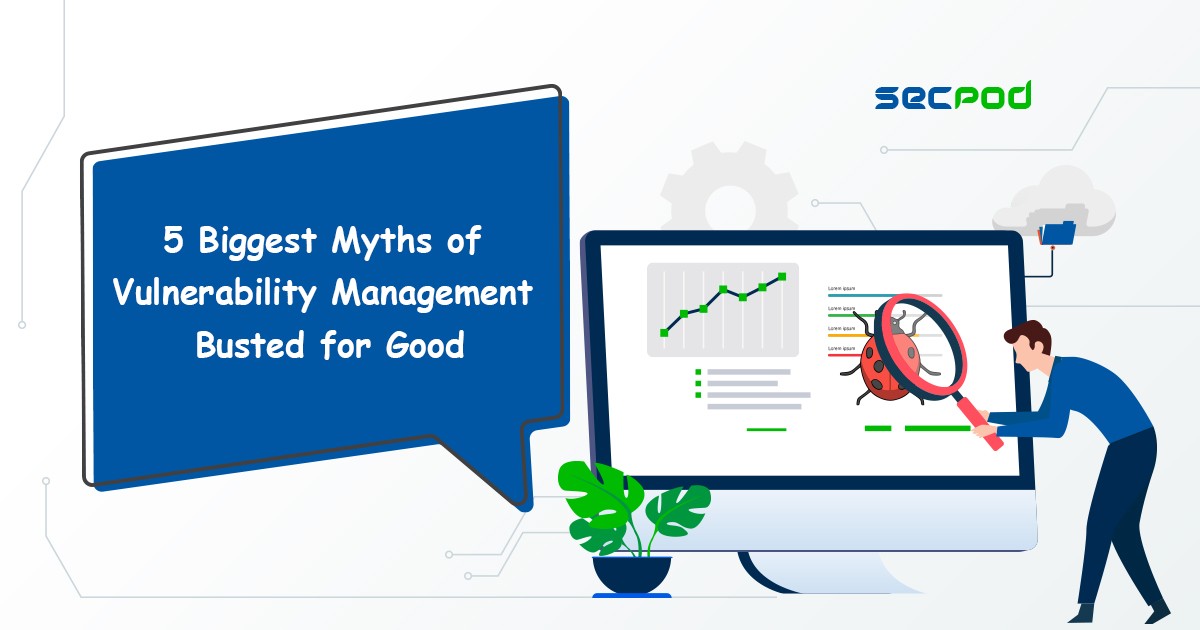Vulnerability management has been a standard practice for more than 15 years now. Vulnerability Scanning tool, assessment, and remediation have occupied an important spot in an organization’s endpoint security practices. However, many old beliefs and approaches that were once working fine have turned out ineffective and outright wrong. A vulnerability management tool can be the new approach that you might require.
Unknowingly sticking to outdated practices may give you a false sense of security and make your endpoints vulnerable to attacks. However, you should have a patch management software. You should wither off obsolete practices and strengthen your vulnerability management process with the right practices. Here are the five biggest myths of vulnerability management:
1. “Vulnerability mitigation is software patching.”
The biggest myth of vulnerability management is that it is the same as software patching. Yes, software patching mitigates vulnerabilities and is an important part of vulnerability management. But vulnerabilities are not confined to just software. There are numerous other places in endpoints where vulnerabilities need to be remediated. Some of them are system configuration settings, registry keys, firewall policies, open ports, etc. You need to scan your endpoints and harden all these settings to secure your networks. Mitigate all kinds of vulnerabilities to have a truly strong security posture.
2. “Periodic vulnerability scans are enough.”
Most organizations conduct periodic vulnerability scans weekly, bi-weekly, monthly, quarterly, or even yearly for compliance audits. The flaw is that you only see instantaneous snapshots of the risks during each risk assessment routine. By the time you wait for the next scanning cycle, new devices and applications might have been installed, and existing applications changed, system settings meddled with, or so many other events. New vulnerabilities will have surfaced, making your endpoints open to exploits. The exact risk posture of your IT infrastructure will always be unknown, leading to unforeseen threats and exploits.
To be proactive about mitigating vulnerabilities, you need to perform continuous vulnerability scans that look for vulnerabilities in your endpoints in real-time. Try and close the gap between vulnerability detection and remediation as best as possible.
3. “Only critical vulnerabilities need to be remediated.”
Focusing just on critical vulnerabilities based on CVSS scores is not an effective way to plan your vulnerability management program. In fact, reports 9 out of 12 actively exploited vulnerabilities by Microsoft in 2019 labels important and not critical. You cannot predict attacks based on just CVSS scores.
A low-level vulnerability detected in a hundred endpoints poses more risk than a critical vulnerability present in five endpoints because it exposes a larger attack surface. Likewise, you should assess other factors such as the impact of a potential exploit, current exploit activity, and the age of the vulnerability. Consider all these factors and tailor a vulnerability mitigation plan specific to your IT landscape.
4. “I need separate tools for vulnerability scanning, assessment, and mitigation.”
This was not a myth during the early days of vulnerability management, but it is now. In 2005, when vulnerability management was an evolving practice, IT admins used open-source tools to scan for vulnerabilities, assess, and mitigate them manually. The same belief exists among IT admins today. Separate tools for each stage introduce a lot of delays, increase costs, and make it practically impossible to measure the effectiveness of your vulnerability management process.
Executes many new-age tools that are built for an entire vulnerability management program, including patching with complete automation. Implement a comprehensive vulnerability management tool and speed-up your process from a single console.
5. “All of endpoint security is just vulnerability management.”
Endpoint security extends beyond just vulnerability management. You need to secure your endpoints with other measures such as endpoint detection and response to detect active threats, hardening system configurations, applying strong application and device control, strong password policies, file integrity monitoring, etc. Add additional layers and strengthen your endpoint security.
If you can work your way through these common vulnerability management myths, you will mend the security gaps and strengthen your security posture to a great extent.
SecPod SanerNow Vulnerability Management Software helps you automate your vulnerability management program with advanced capabilities. With an intelligent continuous scanning algorithm, the world’s largest SCAP feed with 100,000+ vulnerability checks, and integrated patch remediation techniques, you can scan, detect, assess, prioritize, and remediate vulnerabilities efficiently. You can automate all these tasks and implement robust vulnerability management from a centralized cloud-based console.
Sign up for a free personalized demo, and we’ll show you how you can transform your vulnerability management program the right way.

